
Stratified Sampling: A Complete Guide for Surveys
Accurate survey results depend on more than just sample size; they depend on balance.
If certain groups are left out or underrepresented, even the largest survey can deliver skewed or unreliable insights.
Stratified sampling solves this problem by breaking a population into subgroups, or “strata”, based on shared traits like age, gender, income, or region.
Each group is then sampled fairly, ensuring that the final data mirrors the real-world population and forms a stratified random sample.
This approach doesn’t just create a more representative survey; it reduces bias, improves precision, and builds trust in the results.
From politics to healthcare to market research, stratified random sampling is one of the most effective ways to make sure every voice counts, and it’s a core part of Polling.com surveys.
What is Stratified Sampling?
So, what is a stratified random sample?
At its core, a stratified cluster sampling is a research method for dividing your population into meaningful subgroups, called strata, before randomly selecting participants from each one.
For example, if you’re polling voters, you might separate them by age group or region, then draw a stratified random sampling sample from within each category.
This makes stratified sampling different from simple random sampling, where participants are chosen purely at random from the entire population.
It also contrasts with cluster sampling, where whole groups (like schools, cities, or neighborhoods) are randomly selected instead of individuals across strata.
Stratified sampling balances the strengths of randomness with a structure that guarantees representation, which is an approach reflected in the Polling.com methodology.
Why Use Stratified Sampling in Surveys?
Surveys are only as good as the people who take them, and if certain groups are left out, the results can be misleading.
Stratified and random sampling solves this problem by making sure every key subgroup is represented fairly.
Instead of drawing from the population at random and hoping for balance, researchers intentionally divide people into categories, such as age, income, or location, and then select from each group.
This process cuts down on bias and ensures that even smaller groups aren’t overlooked.
The end result is survey data that’s more accurate, more precise, and far more trustworthy for decision-making.
Types of Stratified Sampling
There are two main approaches to this method:
- Proportionate Stratified Sampling
- Disproportionate Stratified Sampling
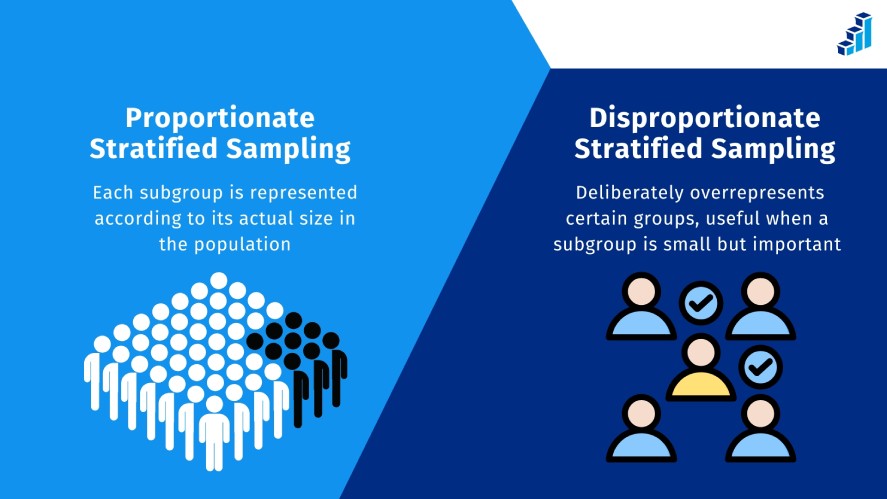
With proportional stratified sampling, each subgroup is represented according to its actual size in the population.
If six out of ten people live in cities and four live in rural areas, the sample keeps that same balance. It’s simple and mirrors the population closely, which makes it ideal for general surveys.
By contrast, disproportionate stratified sampling deliberately overrepresents certain groups.
This is useful when a subgroup is small but important. For example, a minority demographic whose views might otherwise get lost.
Even though it doesn’t follow exact population ratios, it ensures those groups have enough responses to produce reliable insights.
Side by side, proportionate sampling is best when the goal is accuracy across the whole population, while disproportionate sampling is the right choice when you need extra depth from particular groups.
Read More: Sampling Types and Techniques: Strategies for Effective Surveys and Polls
Steps in Conducting Stratified Sampling
Use the five steps below when you want a stratified sampling sample that fairly represents key subgroups. Doing this keeps small but important groups visible and reduces sampling bias.
Step 1: Define the Survey Population
Every survey starts with a clear definition of the population you want to study.
This is the group whose opinions, behaviors, or characteristics you’re trying to measure. Without a well-defined population, results risk being vague or misleading.
Imagine you are running a national election poll. Your population is all eligible voters in the country at the time of the survey. You would exclude groups like minors, non-citizens, or ineligible voters to keep your scope accurate.
Defining the population clearly sets boundaries for the survey and ensures your results speak to the right audience.
Step 2: Identify and Classify Strata
Once the population is clear, the next step is dividing it into strata, which are distinct groups that matter for your research.
Strata should be based on factors that could influence survey results, and they must not overlap.
For example, in the election poll, common strata include age groups (18–29, 30–44, 45–64, 65+), gender, and region (urban vs. rural or state-by-state).
This ensures that younger voters, older voters, men, women, and regional differences all get measured fairly.
By classifying strata carefully, you make sure no subgroup is overshadowed, which strengthens the accuracy of the poll.
Step 3: Allocate Sample Sizes
Now that you’ve divided the population into strata, you need to decide how many respondents to take from each group. This step is called sample allocation.
There are two common approaches:
- Proportionate allocation: The sample matches the population. If 40% of the voters are under 45, then 40% of your sample should also come from that group.
- Disproportionate allocation: You deliberately over-sample smaller groups to ensure enough data for analysis.
In the example above, suppose only 10% of eligible voters live in rural areas. If you use proportionate allocation, you’ll survey 10% rural respondents.
But if rural voter behavior is crucial to your study, you might use disproportionate allocation to boost their share to 20%, ensuring stronger insights.
Allocating carefully keeps your sample balanced and meaningful.
Step 4: Randomly Select Within Each Stratum
Once sample sizes are set, the next step is random selection within each stratum.
This ensures fairness and avoids bias by giving every individual in the group an equal chance of being chosen.
In the election survey, you might randomly pick voters from a state’s registration database, ensuring you select across age and gender groups within that state.
If your stratum is “18–29-year-olds in urban areas”, you would randomly select names from that subgroup until you reach the assigned sample size.
Randomization prevents researchers from cherry-picking participants, keeping the survey reliable and trustworthy.
Step 5: Merge Data For Full Analysis
The final step is to combine all the stratum samples into one dataset.
At this stage, you may apply weights to adjust for over or under-sampling so that results truly reflect the full population.
If you oversampled rural voters at 20% when they make up only 10% of the population, you’d apply a weight to bring their influence back down to 10%.
This prevents skewed results while still allowing detailed analysis of rural voters.
Once merged and weighted, the dataset is ready for analysis and fits the stratified sampling definition accurately, giving you results that are both representative and precise.
Use Cases of Stratified Sampling in Surveys
Because stratified sampling captures diversity while reducing bias, it shows up in many areas of research.
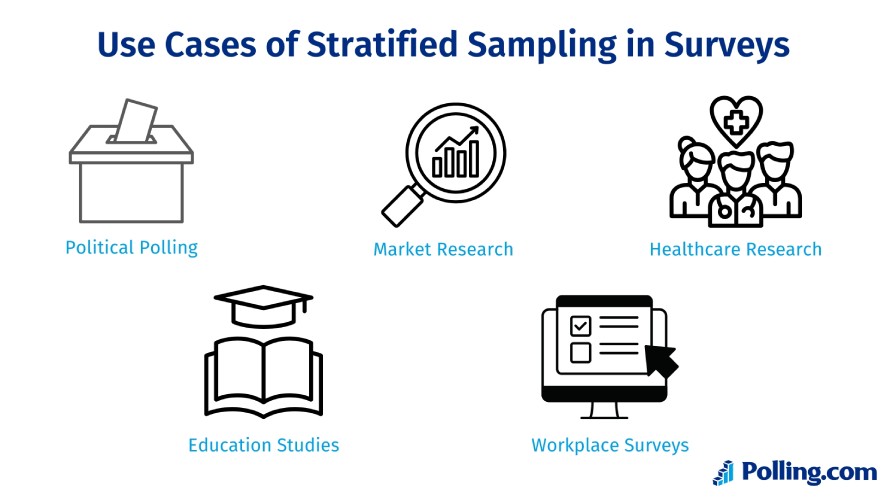
Political pollsters use it to mirror the voting population, dividing respondents by age, education, region, or gender to predict outcomes more accurately.
Market researchers depend on it to study different customer groups, such as budget buyers, mid-range shoppers, and premium spenders, without letting one category skew the findings.
In healthcare, stratified sampling makes it possible to compare patient experiences by treatment type, diagnosis, or age, leading to more reliable insights.
Educators and administrators also use it when they want feedback separated by grade level or program.
Even workplace surveys benefit, since responses can be balanced across departments and seniority levels.
No matter the field, the method ensures that every relevant group has a voice in the results.
Real-World Stratified Sample Examples
Stratified sampling isn’t just a theory; it’s a method used in many real-world studies to make sure results reflect reality as closely as possible.
Here are some stratified sampling examples and how stratified sampling is applied in different fields.
Political Example: Election Polling
In political surveys, stratified sampling is one of the most reliable ways to capture diverse voter behavior.
A national election poll, for instance, can be stratified first by state, then by age groups within each state.
This ensures that a 19-year-old voter in California and a 65-year-old voter in Texas are both represented fairly in the results.
Without stratification, certain states or age groups could dominate the sample, skewing the predictions and reducing trust in the poll.
Healthcare Example: Patient Satisfaction Surveys
Hospitals and clinics often rely on stratified sampling to gather balanced insights across different patient experiences.
A hospital might stratify patients into outpatient and inpatient categories before randomly selecting participants from each group.
This prevents the survey from being dominated by outpatients (who may be far more numerous) while ensuring that inpatients (whose experiences are often more intensive) are equally represented.
Education Example: University Feedback
Education researchers use stratified sampling to compare opinions across distinct academic groups.
A university feedback survey, for example, could separate undergraduate students from postgraduate students.
By stratifying this way, administrators can see whether undergraduates face challenges like crowded lecture halls, while postgraduates highlight issues with research resources.
The stratification helps surface group-specific feedback that might otherwise be diluted in a combined sample.
Business Example: Retail Market Insights
Stratified simple random sampling is also valuable in business research.
A retail chain, for instance, could stratify customers by urban vs. rural locations when conducting a satisfaction survey.
Urban shoppers may prioritize fast delivery and online options, while rural customers might focus on in-store availability and service quality.
By stratifying the sample, the company ensures both perspectives are captured, leading to better-informed decisions for marketing and operations.
Advantages of Stratified Sampling
Stratified sampling stands out because it ensures that minority groups are not overlooked.
In a simple random sample, smaller segments of the population, such as rural households, niche customer groups, or underrepresented demographics, might be missed entirely.
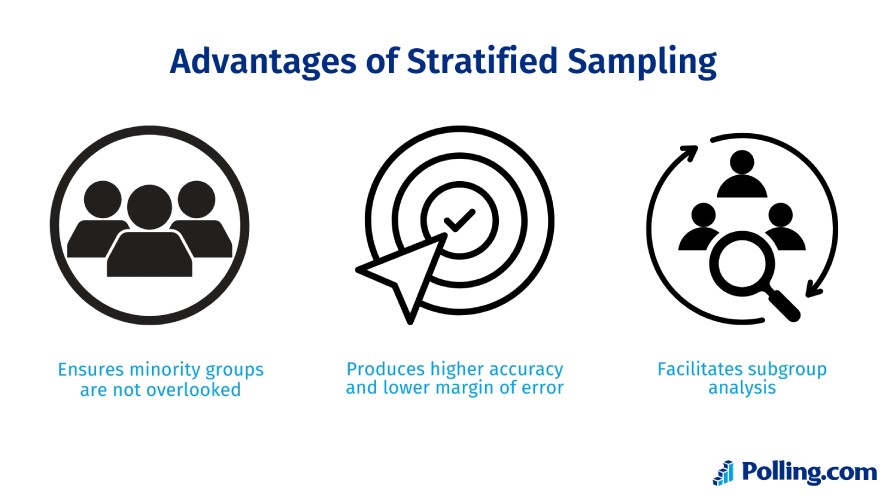
Stratification guarantees that their perspectives are included, making the results more representative.
Another advantage is the boost in accuracy.
By dividing the population into well-defined subgroups, researchers reduce variation within each stratum.
This leads to a lower margin of error and more precise results, even without dramatically increasing sample size.
For organizations that rely on trustworthy data, this efficiency is a major benefit.
Finally, stratified sampling makes subgroup analysis far easier.
Because each group is sampled intentionally, researchers can directly compare their response.
For example, analyzing how customer satisfaction differs between first-time buyers and long-term customers.
This level of insight provides more actionable findings than a single overall average ever could.
Challenges and Limitations
While stratified sampling offers many advantages, it also comes with certain challenges.
One of the biggest hurdles is the need for detailed population information upfront.
Researchers must know enough about the population to define meaningful strata, such as age groups, income levels, or regions. Otherwise, the sampling framework falls apart.
Another limitation is the added complexity and resources required.
Unlike simple random sampling, random sampling stratified involves extra planning: identifying strata, allocating sample sizes, and running random selections within each subgroup.
This process can be more time-consuming and costly, especially for large-scale studies.
Finally, there is always the risk of misclassification.
If individuals are placed into the wrong group, for example, a voter is incorrectly categorized into the wrong age bracket, the accuracy of the results can suffer.
Misclassification can distort subgroup representation and, in turn, weaken the conclusions drawn from the data.
Comparison of Stratified Sampling vs. Other Methods
Stratified sampling method often gets compared with other common approaches like random, systematic, and cluster sampling.
Stratified Sampling vs. Random Sampling
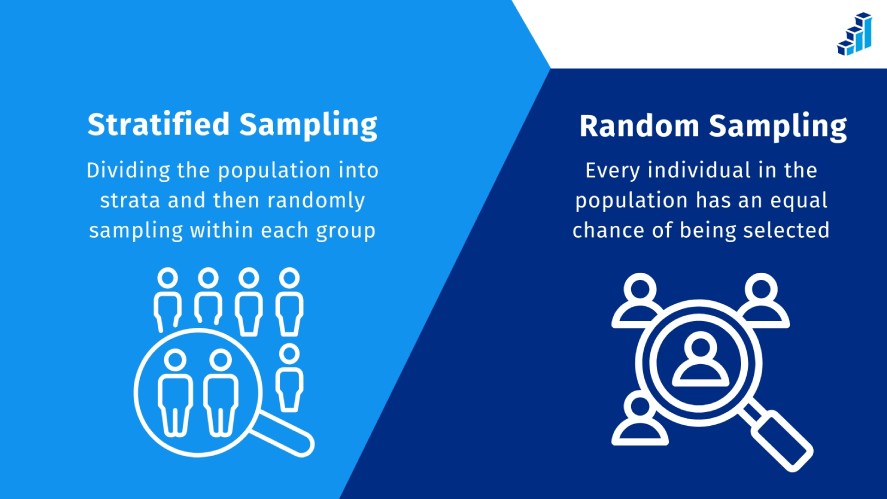
In simple random sampling, every individual in the population has an equal chance of being selected.
While this is straightforward and easy to apply, it doesn’t guarantee that smaller subgroups will be represented fairly.
Stratified sampling improves on this by dividing the population into strata and then randomly sampling within each group.
This ensures that minority or niche groups are included in the final dataset, leading to more balanced and accurate results.
Stratified Sampling vs. Systematic Sampling
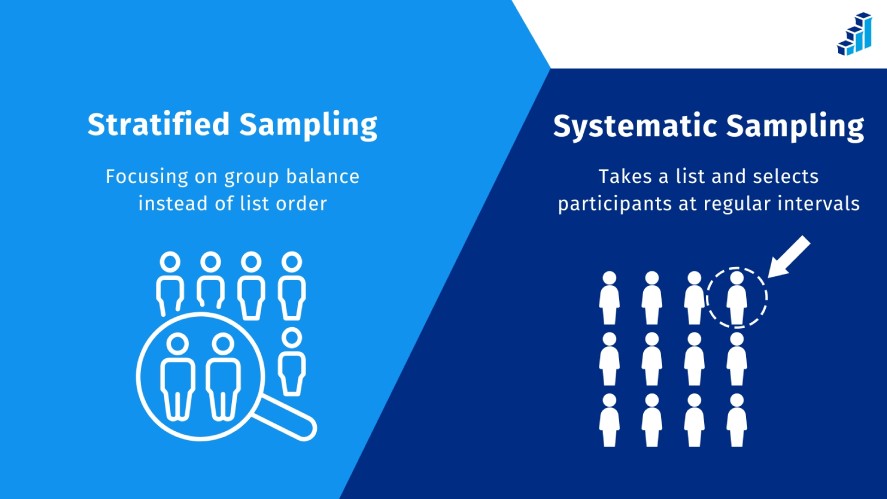
Systematic sampling takes a list of the population and selects participants at regular intervals, such as every 10th person.
This method is simple but can introduce hidden biases if the list has patterns. For example, if every 10th entry belongs to a similar subgroup.
Stratified random sampling method avoids this pitfall by focusing on group balance instead of list order.
By drawing from each defined stratum, it ensures representation even when the population data might be ordered in a skewed way.
Stratified Sampling vs. Cluster Sampling
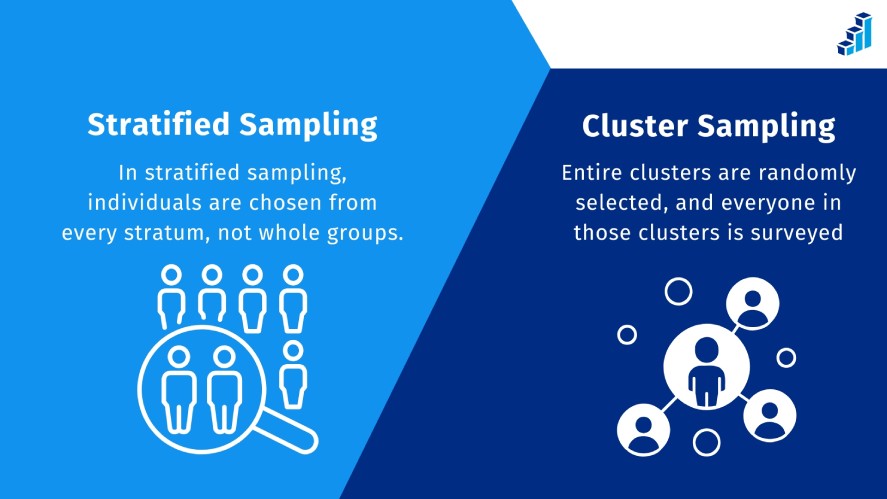
Cluster sampling is often confused with stratified sampling because both involve dividing the population into groups.
However, the key difference between stratified and cluster sampling is how the groups are used.
In cluster sampling, entire clusters, such as neighborhoods, schools, or hospitals, are randomly selected, and everyone in those clusters is surveyed.
In stratified sampling, individuals are chosen from every stratum, not whole groups.
This difference between cluster and stratified sampling makes stratified sampling more accurate for studies where subgroup representation is critical, such as political polling.
Cluster sampling, on the other hand, is easier and cheaper to conduct, making it better for large-scale studies where budget or logistics are more important than precision.
Best Practices for Applying Stratified Sampling
To get the most out of stratified sampling, the first step is to define strata clearly and ensure there are no overlaps.
Each subgroup should be distinct, such as separating respondents by age ranges like 18–24, 25–34, and so on, so that participants can only belong to one category.
Clear boundaries prevent confusion and ensure that the results accurately reflect each segment.
Within each stratum, it’s essential to use random selection. This keeps the process unbiased and prevents researchers from favoring certain individuals or groups.
For example, if you are stratifying a survey of employees by department, every employee within a department should have an equal chance of being selected.
Finally, testing proportions before moving forward is important to prevent skew.
By checking that the sample size in each stratum matches its proportion in the total population, you ensure balanced representation.
For instance, if 60% of your customer base falls into the 18–34 age group, then around 60% of your survey responses should come from that group.
Conclusion
Stratified sampling remains one of the most effective ways to improve the accuracy and fairness of survey research.
By carefully defining groups, ensuring randomness within each stratum, and keeping proportions balanced, researchers can capture insights that truly represent the population.
If you want to design surveys that deliver reliable results and avoid common pitfalls, random stratified sampling should be a go-to method.
For anyone looking to run surveys with accuracy and ease, check out Polling.com data sampling methods and start for free.
